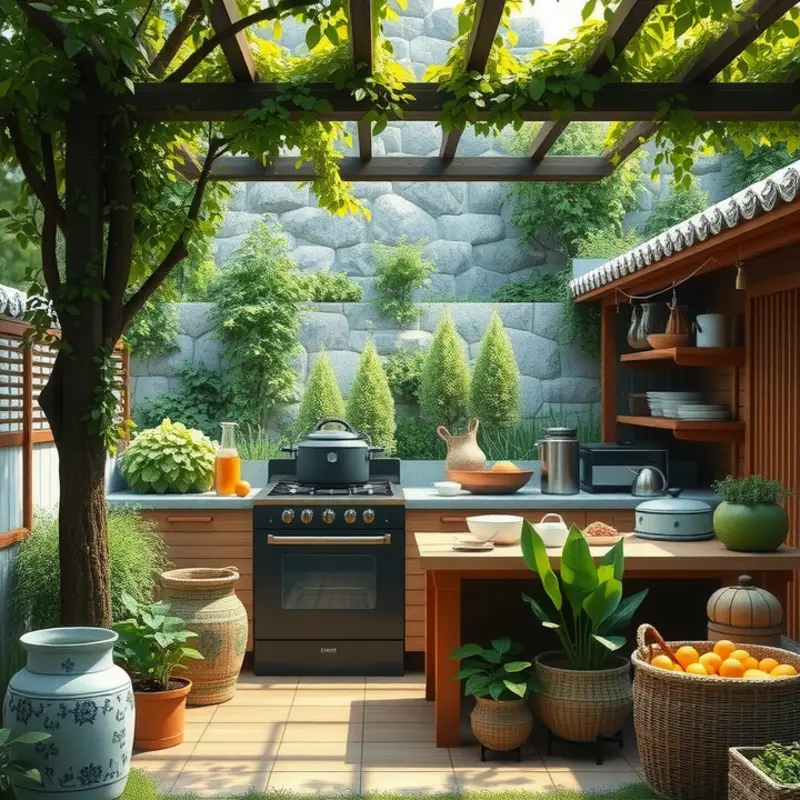Kitchen spaces serve not only as practical environments for meal prep but also as reflections of culture, heritage, and community. Around the globe, these sanctuaries of sustenance tell unique stories through their architectural designs, cooking implements, and the rituals associated with them. This exploration dives into the kitchens that define cultures, revealing the traditions and skills passed down through generations, inviting food enthusiasts and culturally-curious readers to appreciate the artistry embedded in these beloved spaces.
The Heart of the Home: Traditional Kitchens Around the World

Kitchens serve as the heart of the home, a place where cultural traditions are nurtured and shared. Across the globe, traditional kitchens vary widely in design and function yet share common themes of community, functionality, and cultural expression.
In Ethiopia, kitchens are vibrant spaces where culinary practices are deeply intertwined with social rituals. A typical Ethiopian kitchen is centered around the mitad, a flat griddle for baking injera, the staple sourdough flatbread. Kitchens often incorporate open fire stoves and are designed to accommodate communal eating and cooking. Meals are shared on large platters, emphasizing unity and the collective spirit of eating together. This setup supports the Ethiopian cultural norm of expressing camaraderie and hospitality.
The Japanese kitchen presents a stark contrast with its minimalist and ordered design, reflecting the cultural values of simplicity and harmony. Traditional Japanese kitchens are compact, maximizing efficiency and practicality in limited spaces. They typically feature clean lines and uncluttered surfaces, employing natural materials like wood and bamboo. The focus is on balance and the thoughtful arrangement of elements, mirroring the principles of Zen philosophy. This meticulous approach highlights respect for ingredients and the importance of mindful food preparation, such as making sushi or a simple miso soup.
In South America, particularly in Peru, many traditional kitchens are extensions of the natural environment. Constructed primarily from adobe, these kitchens are designed to retain heat, vital for cooking in cooler highland climates. The use of clay ovens, or hornos, is prevalent, providing a consistent heat source for dishes like pachamanca, a traditional meat and vegetable bake. These communal spaces are multifunctional, often serving as gathering points where stories and traditions are passed down through generations.
The kitchens in the Mediterranean, particularly in Greece and Italy, are open and expansive, crafted to accommodate large family gatherings. The design often incorporates large wooden tables for kneading dough and preparing meals communally. Stone hearths or wood-fired ovens are common, reflecting a deep-rooted connection to ancient cooking practices. These kitchens are reflections of a lifestyle that celebrates abundance, with meals serving as a significant social event for family and community bonding.
Each traditional kitchen is a testament to the surrounding culture and its values. Whether shaped by climate, materials, or social customs, these spaces maintain the central essence of hospitality and togetherness. They also highlight sustainable practices inherent in traditional kitchen designs, such as eco-smart kitchen storage techniques, underscoring a natural efficiency and resourcefulness. More insights on sustainable practices can be explored in eco-smart kitchen storage.
Traditional kitchens provide more than a space to cook; they serve as gateways to cultural understanding. These kitchens encapsulate stories, heritage, and social dynamics, ultimately forming the cornerstone of familial and community life.
Modern Adaptations: Culinary Spaces in Urban Contexts

Urban kitchens around the globe stand as microcosms of their respective cities, adapting to modern lifestyles without losing their cultural essence. Whether nestled within a compact Parisian apartment or sprawling across a Tokyo loft, these culinary spaces reflect an amalgam of convenience and tradition, blending the best of both worlds.
In Paris, the typical city kitchen is often small, requiring efficiency and clever design to maximize utility. Parisians often incorporate traditional elements, like cast iron pots or copper pans, maintaining a link to their culinary heritage. Yet, these kitchens simultaneously embrace the need for speed by integrating speedy cooking techniques such as sous-vide. This harmony allows dishes rooted in French tradition to be prepared with contemporary flair.
In contrast, Tokyo’s urban kitchens offer a unique juxtaposition of minimalism and warmth. Japanese culture emphasizes seasonal ingredients, a practice still alive in the heart of this bustling metropolis. Even in the smallest kitchens, preserving traditions like sushi-making involves meticulous care and simplicity. This has evolved with urban needs, using compact appliances that fit effortlessly into available spaces.
The concept of local and seasonal ingredients extends across these urban centers, each city offering its distinct culinary palette. Rome, for example, treasures tomatoes and artichokes, indispensable in local cuisines. In New York, kitchen spaces celebrate diversity, incorporating flavors and techniques from around the world, epitomizing global fusion cuisine. Here, a home cook might pair Italian herbs with Mexican spices, crafting unique dishes that draw on varied heritages.
While space constraints in crowded cities can challenge traditional cooking, innovative storage solutions and culinary creativity rise to the occasion. Cities like London witness this evolution firsthand, where sustainable practices like eco-smart storage reflect a commitment to reducing waste and preserving resources. This paradigm shift is as much about preserving global flavors as it is about respecting the planet.
Today’s home kitchens thus become crucibles for intergenerational culinary wisdom and contemporary innovation. The newfound ease of preparing dishes once considered arduous promotes inclusivity, allowing younger generations to engage with their culinary past. Families preserve cultural rites through recipes passed down, while also trying new practices like plant-based eating, thus embracing both continuity and change.
Ultimately, urban kitchens unite a world of flavors and techniques. These spaces, though constrained by city living, evolve to become centers of creativity and cultural exchange. As cities grow denser, the kitchen remains a cherished retreat and a testament to the resilience of culinary traditions in the ever-changing urban landscape.
Final words
The journey through culturally significant kitchen spaces reveals not just places where meals are prepared, but narratives that encapsulate history, community, and identity. Each kitchen, whether traditional or modern, serves as a canvas on which culinary heritage is displayed and adapted. Understanding these spaces enriches our appreciation for global cuisines and encourages a respectful exploration of diverse food cultures. As home cooks and food enthusiasts, let’s embrace these traditions, honoring the stories behind every recipe and the shared experiences that bring us together at the table.








